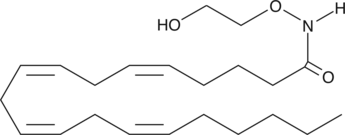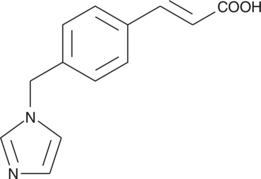Chemicals
Showing 30601–30750 of 41137 results
-
Oxtriphylline is a choline salt form of theophylline (Item No. 23760). It dose-dependently decreases histamine-induced contractions of isolated guinea pig trachea and increases cAMP levels in guinea pig tracheal smooth muscle cells in vitro.{39503} Formulations containing oxtriphylline were previously used in the treatment of asthma.
Brand:CaymanSKU:24006 - 100 mgAvailable on backorder
Oxtriphylline is a choline salt form of theophylline (Item No. 23760). It dose-dependently decreases histamine-induced contractions of isolated guinea pig trachea and increases cAMP levels in guinea pig tracheal smooth muscle cells in vitro.{39503} Formulations containing oxtriphylline were previously used in the treatment of asthma.
Brand:CaymanSKU:24006 - 50 mgAvailable on backorder
Oxtriphylline is a choline salt form of theophylline (Item No. 23760). It dose-dependently decreases histamine-induced contractions of isolated guinea pig trachea and increases cAMP levels in guinea pig tracheal smooth muscle cells in vitro.{39503} Formulations containing oxtriphylline were previously used in the treatment of asthma.
Brand:CaymanSKU:24006 - 500 mgAvailable on backorder
Naturally occurring oxysterols are products of cholesterol oxidation that can stimulate the hedgehog (Hh) signaling pathway in target cells associated with cardiovascular disease and with bone formation.{18498} Depending on the target cell, activation of Hh signaling can modulate inflammatory responses to additional atherogenic factors such as lesion-producing macrophages or enable osteoblast differentiation.{18500,18499} Oxy-16 is a synthetic oxysterol compound that may function as an antagonist of hedgehog activity. Published data regarding its efficacy remains forthcoming.
Brand:CaymanSKU:9000395 - 1 mgAvailable on backorder
Naturally occurring oxysterols are products of cholesterol oxidation that can stimulate the hedgehog (Hh) signaling pathway in target cells associated with cardiovascular disease and with bone formation.{18498} Depending on the target cell, activation of Hh signaling can modulate inflammatory responses to additional atherogenic factors such as lesion-producing macrophages or enable osteoblast differentiation.{18500,18499} Oxy-16 is a synthetic oxysterol compound that may function as an antagonist of hedgehog activity. Published data regarding its efficacy remains forthcoming.
Brand:CaymanSKU:9000395 - 10 mgAvailable on backorder
Naturally occurring oxysterols are products of cholesterol oxidation that can stimulate the hedgehog (Hh) signaling pathway in target cells associated with cardiovascular disease and with bone formation.{18498} Depending on the target cell, activation of Hh signaling can modulate inflammatory responses to additional atherogenic factors such as lesion-producing macrophages or enable osteoblast differentiation.{18500,18499} Oxy-16 is a synthetic oxysterol compound that may function as an antagonist of hedgehog activity. Published data regarding its efficacy remains forthcoming.
Brand:CaymanSKU:9000395 - 5 mgAvailable on backorder
AEA acts as an endogenous mimic of Δ9-THC, the psychotropic component of marijuana.{1134} oxy-AEA is the O-alkyl-N-acyl oxyhomologue of AEA. oxy-AEA is selective for the peripheral cannabinoid (CB2) receptor with Ki values of 0.47 and 0.081 µM for hCB1 and hCB2, respectively.{14122} In comparison, AEA has a greater affinity for the central cannabinoid (CB1) receptor with Ki values of 0.07 and 0.18 µM for hCB1 and hCB2, respectively. oxy-AEA is the first known fatty acid amide with a reversed CB1/CB2 affinity ratio.
Brand:CaymanSKU:10008642 - 10 mgAvailable on backorder
AEA acts as an endogenous mimic of Δ9-THC, the psychotropic component of marijuana.{1134} oxy-AEA is the O-alkyl-N-acyl oxyhomologue of AEA. oxy-AEA is selective for the peripheral cannabinoid (CB2) receptor with Ki values of 0.47 and 0.081 µM for hCB1 and hCB2, respectively.{14122} In comparison, AEA has a greater affinity for the central cannabinoid (CB1) receptor with Ki values of 0.07 and 0.18 µM for hCB1 and hCB2, respectively. oxy-AEA is the first known fatty acid amide with a reversed CB1/CB2 affinity ratio.
Brand:CaymanSKU:10008642 - 25 mgAvailable on backorder
AEA acts as an endogenous mimic of Δ9-THC, the psychotropic component of marijuana.{1134} oxy-AEA is the O-alkyl-N-acyl oxyhomologue of AEA. oxy-AEA is selective for the peripheral cannabinoid (CB2) receptor with Ki values of 0.47 and 0.081 µM for hCB1 and hCB2, respectively.{14122} In comparison, AEA has a greater affinity for the central cannabinoid (CB1) receptor with Ki values of 0.07 and 0.18 µM for hCB1 and hCB2, respectively. oxy-AEA is the first known fatty acid amide with a reversed CB1/CB2 affinity ratio.
Brand:CaymanSKU:10008642 - 5 mgAvailable on backorder
AEA acts as an endogenous mimic of Δ9-THC, the psychotropic component of marijuana.{1134} oxy-AEA is the O-alkyl-N-acyl oxyhomologue of AEA. oxy-AEA is selective for the peripheral cannabinoid (CB2) receptor with Ki values of 0.47 and 0.081 µM for hCB1 and hCB2, respectively.{14122} In comparison, AEA has a greater affinity for the central cannabinoid (CB1) receptor with Ki values of 0.07 and 0.18 µM for hCB1 and hCB2, respectively. oxy-AEA is the first known fatty acid amide with a reversed CB1/CB2 affinity ratio.
Brand:CaymanSKU:10008642 - 50 mgAvailable on backorder
Oxybutynin is an antagonist of muscarinic acetylcholine receptors (Kis = 5, 14.5, 3.7, 5.3, and 40 nM for human recombinant M1-5, respectively).{39586} It inhibits intracellular calcium mobilization induced by carbamoylcholine (carbachol; Item No. 14486) in bladder smooth muscle and submandibular gland cells isolated from cynomolgus monkeys (Kis = 2 and 1 nM, respectively).{39587} Oxybutynin inhibits volume-induced bladder contraction (VIBC) and oxotremorine-induced salivation (OIS) in rats (ID50s = 0.062 and 0.089 mg/kg, respectively).{39586} It also increases pupil diameter (PD) and locomotor activity (LMA; ED50s = 0.29 and 0.52 mg/kg, respectively) and decreases small intestinal transit (SIT; ID50 = 0.22 mg/kg) in rats. Formulations containing oxybutynin have been used in the treatment of overactive bladder.
Brand:CaymanSKU:23825 - 1 gAvailable on backorder
Oxybutynin is an antagonist of muscarinic acetylcholine receptors (Kis = 5, 14.5, 3.7, 5.3, and 40 nM for human recombinant M1-5, respectively).{39586} It inhibits intracellular calcium mobilization induced by carbamoylcholine (carbachol; Item No. 14486) in bladder smooth muscle and submandibular gland cells isolated from cynomolgus monkeys (Kis = 2 and 1 nM, respectively).{39587} Oxybutynin inhibits volume-induced bladder contraction (VIBC) and oxotremorine-induced salivation (OIS) in rats (ID50s = 0.062 and 0.089 mg/kg, respectively).{39586} It also increases pupil diameter (PD) and locomotor activity (LMA; ED50s = 0.29 and 0.52 mg/kg, respectively) and decreases small intestinal transit (SIT; ID50 = 0.22 mg/kg) in rats. Formulations containing oxybutynin have been used in the treatment of overactive bladder.
Brand:CaymanSKU:23825 - 10 gAvailable on backorder
Oxybutynin is an antagonist of muscarinic acetylcholine receptors (Kis = 5, 14.5, 3.7, 5.3, and 40 nM for human recombinant M1-5, respectively).{39586} It inhibits intracellular calcium mobilization induced by carbamoylcholine (carbachol; Item No. 14486) in bladder smooth muscle and submandibular gland cells isolated from cynomolgus monkeys (Kis = 2 and 1 nM, respectively).{39587} Oxybutynin inhibits volume-induced bladder contraction (VIBC) and oxotremorine-induced salivation (OIS) in rats (ID50s = 0.062 and 0.089 mg/kg, respectively).{39586} It also increases pupil diameter (PD) and locomotor activity (LMA; ED50s = 0.29 and 0.52 mg/kg, respectively) and decreases small intestinal transit (SIT; ID50 = 0.22 mg/kg) in rats. Formulations containing oxybutynin have been used in the treatment of overactive bladder.
Brand:CaymanSKU:23825 - 25 gAvailable on backorder
Oxybutynin is an antagonist of muscarinic acetylcholine receptors (Kis = 5, 14.5, 3.7, 5.3, and 40 nM for human recombinant M1-5, respectively).{39586} It inhibits intracellular calcium mobilization induced by carbamoylcholine (carbachol; Item No. 14486) in bladder smooth muscle and submandibular gland cells isolated from cynomolgus monkeys (Kis = 2 and 1 nM, respectively).{39587} Oxybutynin inhibits volume-induced bladder contraction (VIBC) and oxotremorine-induced salivation (OIS) in rats (ID50s = 0.062 and 0.089 mg/kg, respectively).{39586} It also increases pupil diameter (PD) and locomotor activity (LMA; ED50s = 0.29 and 0.52 mg/kg, respectively) and decreases small intestinal transit (SIT; ID50 = 0.22 mg/kg) in rats. Formulations containing oxybutynin have been used in the treatment of overactive bladder.
Brand:CaymanSKU:23825 - 5 gAvailable on backorder
Oxybutynin-d10 is intended for use as an internal standard for the quantification of oxybutynin (Item No. 23825) by GC- or LC-MS. Oxybutynin is an antagonist of muscarinic acetylcholine receptors (Kis = 5, 14.5, 3.7, 5.3, and 40 nM for human recombinant M1-5, respectively).{39586} It inhibits intracellular calcium mobilization induced by carbamoylcholine (carbachol; Item No. 14486) in bladder smooth muscle and submandibular gland cells isolated from cynomolgus monkeys (Kis = 2 and 1 nM, respectively).{39587} Oxybutynin inhibits volume-induced bladder contraction (VIBC) and oxotremorine-induced salivation (OIS) in rats (ID50s = 0.062 and 0.089 mg/kg, respectively).{39586} It also increases pupil diameter (PD) and locomotor activity (LMA; ED50s = 0.29 and 0.52 mg/kg, respectively) and decreases small intestinal transit (SIT; ID50 = 0.22 mg/kg) in rats. Formulations containing oxybutynin have been used in the treatment of overactive bladder.
Brand:CaymanSKU:10010655 - 1 mgAvailable on backorder
Oxybutynin-d10 is intended for use as an internal standard for the quantification of oxybutynin (Item No. 23825) by GC- or LC-MS. Oxybutynin is an antagonist of muscarinic acetylcholine receptors (Kis = 5, 14.5, 3.7, 5.3, and 40 nM for human recombinant M1-5, respectively).{39586} It inhibits intracellular calcium mobilization induced by carbamoylcholine (carbachol; Item No. 14486) in bladder smooth muscle and submandibular gland cells isolated from cynomolgus monkeys (Kis = 2 and 1 nM, respectively).{39587} Oxybutynin inhibits volume-induced bladder contraction (VIBC) and oxotremorine-induced salivation (OIS) in rats (ID50s = 0.062 and 0.089 mg/kg, respectively).{39586} It also increases pupil diameter (PD) and locomotor activity (LMA; ED50s = 0.29 and 0.52 mg/kg, respectively) and decreases small intestinal transit (SIT; ID50 = 0.22 mg/kg) in rats. Formulations containing oxybutynin have been used in the treatment of overactive bladder.
Brand:CaymanSKU:10010655 - 500 µgAvailable on backorder
Oxychlororaphine is a phenazine microbial metabolite that has been found in a variety of bacteria and has anticancer, antibacterial, and antifungal activities.{48473,48474} It is cytotoxic to A549, HeLa, and SW480 cancer cells (IC50s = 32-40 μM).{48473} Oxychlororaphine halts the cell cycle at the G1 phase and induces apoptosis in A549 cells. It is active against Streptomyces bacteria and T. mentagrophytes, E. floccosum, C. albicans, M. audouini, and B. dermatitidis fungi when used at concentrations ranging from 12.5 to 50 ppm.{48474}
Brand:CaymanSKU:27624 - 10 mgAvailable on backorder
Oxychlororaphine is a phenazine microbial metabolite that has been found in a variety of bacteria and has anticancer, antibacterial, and antifungal activities.{48473,48474} It is cytotoxic to A549, HeLa, and SW480 cancer cells (IC50s = 32-40 μM).{48473} Oxychlororaphine halts the cell cycle at the G1 phase and induces apoptosis in A549 cells. It is active against Streptomyces bacteria and T. mentagrophytes, E. floccosum, C. albicans, M. audouini, and B. dermatitidis fungi when used at concentrations ranging from 12.5 to 50 ppm.{48474}
Brand:CaymanSKU:27624 - 100 mgAvailable on backorder
Oxychlororaphine is a phenazine microbial metabolite that has been found in a variety of bacteria and has anticancer, antibacterial, and antifungal activities.{48473,48474} It is cytotoxic to A549, HeLa, and SW480 cancer cells (IC50s = 32-40 μM).{48473} Oxychlororaphine halts the cell cycle at the G1 phase and induces apoptosis in A549 cells. It is active against Streptomyces bacteria and T. mentagrophytes, E. floccosum, C. albicans, M. audouini, and B. dermatitidis fungi when used at concentrations ranging from 12.5 to 50 ppm.{48474}
Brand:CaymanSKU:27624 - 25 mgAvailable on backorder
Oxychlororaphine is a phenazine microbial metabolite that has been found in a variety of bacteria and has anticancer, antibacterial, and antifungal activities.{48473,48474} It is cytotoxic to A549, HeLa, and SW480 cancer cells (IC50s = 32-40 μM).{48473} Oxychlororaphine halts the cell cycle at the G1 phase and induces apoptosis in A549 cells. It is active against Streptomyces bacteria and T. mentagrophytes, E. floccosum, C. albicans, M. audouini, and B. dermatitidis fungi when used at concentrations ranging from 12.5 to 50 ppm.{48474}
Brand:CaymanSKU:27624 - 5 mgAvailable on backorder
Oxymatrine is a natural alkaloid isolated from the root of S. flavescens, an herb used in traditional Chinese herbal medicine.{23832} It has antiviral properties, inhibiting the replication of hepatitis B alone and in combination with lamivudine.{23830,23834} Oxymatrine also prevents fibrosis in a number of organs including liver, at least in part by interfering with TGF-β signaling.{23835,23833} This compound also induces apoptosis in certain cancer cells and ameliorates inflammation by impairing the translocation of nuclear factors-κB.{23832,23831}
Brand:CaymanSKU:-Oxymatrine is a natural alkaloid isolated from the root of S. flavescens, an herb used in traditional Chinese herbal medicine.{23832} It has antiviral properties, inhibiting the replication of hepatitis B alone and in combination with lamivudine.{23830,23834} Oxymatrine also prevents fibrosis in a number of organs including liver, at least in part by interfering with TGF-β signaling.{23835,23833} This compound also induces apoptosis in certain cancer cells and ameliorates inflammation by impairing the translocation of nuclear factors-κB.{23832,23831}
Brand:CaymanSKU:-Oxymatrine is a natural alkaloid isolated from the root of S. flavescens, an herb used in traditional Chinese herbal medicine.{23832} It has antiviral properties, inhibiting the replication of hepatitis B alone and in combination with lamivudine.{23830,23834} Oxymatrine also prevents fibrosis in a number of organs including liver, at least in part by interfering with TGF-β signaling.{23835,23833} This compound also induces apoptosis in certain cancer cells and ameliorates inflammation by impairing the translocation of nuclear factors-κB.{23832,23831}
Brand:CaymanSKU:-Oxymatrine is a natural alkaloid isolated from the root of S. flavescens, an herb used in traditional Chinese herbal medicine.{23832} It has antiviral properties, inhibiting the replication of hepatitis B alone and in combination with lamivudine.{23830,23834} Oxymatrine also prevents fibrosis in a number of organs including liver, at least in part by interfering with TGF-β signaling.{23835,23833} This compound also induces apoptosis in certain cancer cells and ameliorates inflammation by impairing the translocation of nuclear factors-κB.{23832,23831}
Brand:CaymanSKU:-Oxyphenbutazone is a metabolite of phenylbutazone (Item No. 70400). Both compounds were identified as having anti-inflammatory effects in early studies, and, as a result, are considered NSAIDs.{30271} Interestingly, the effects of the two compounds in animal models differ, with phenylbutazone having anti-inflammatory effects in rheumatic diseases and oxyphenbutazone reducing edema in certain types of acute inflammation.{30271} Oxyphenbutazone is a poor inhibitor of prostaglandin synthesis, but, like other NSAIDs, it inhibits organic anion transporter 1 (Ki = 32 µM).{30270,30268} It inhibits the growth of MH60/BSF-2 cells induced by IL-6 (IC50 = 7.5 µM).{29361} Oxyphenbutazone stimulates neurite outgrowth at 1.5 µM and sensitizes M. tuberculosis to antimicrobials.{30272,30269}
Brand:CaymanSKU:-Available on backorder
Oxyphenbutazone is a metabolite of phenylbutazone (Item No. 70400). Both compounds were identified as having anti-inflammatory effects in early studies, and, as a result, are considered NSAIDs.{30271} Interestingly, the effects of the two compounds in animal models differ, with phenylbutazone having anti-inflammatory effects in rheumatic diseases and oxyphenbutazone reducing edema in certain types of acute inflammation.{30271} Oxyphenbutazone is a poor inhibitor of prostaglandin synthesis, but, like other NSAIDs, it inhibits organic anion transporter 1 (Ki = 32 µM).{30270,30268} It inhibits the growth of MH60/BSF-2 cells induced by IL-6 (IC50 = 7.5 µM).{29361} Oxyphenbutazone stimulates neurite outgrowth at 1.5 µM and sensitizes M. tuberculosis to antimicrobials.{30272,30269}
Brand:CaymanSKU:-Available on backorder
Oxyphenbutazone is a metabolite of phenylbutazone (Item No. 70400). Both compounds were identified as having anti-inflammatory effects in early studies, and, as a result, are considered NSAIDs.{30271} Interestingly, the effects of the two compounds in animal models differ, with phenylbutazone having anti-inflammatory effects in rheumatic diseases and oxyphenbutazone reducing edema in certain types of acute inflammation.{30271} Oxyphenbutazone is a poor inhibitor of prostaglandin synthesis, but, like other NSAIDs, it inhibits organic anion transporter 1 (Ki = 32 µM).{30270,30268} It inhibits the growth of MH60/BSF-2 cells induced by IL-6 (IC50 = 7.5 µM).{29361} Oxyphenbutazone stimulates neurite outgrowth at 1.5 µM and sensitizes M. tuberculosis to antimicrobials.{30272,30269}
Brand:CaymanSKU:-Available on backorder
Oxyphenbutazone is a metabolite of phenylbutazone (Item No. 70400). Both compounds were identified as having anti-inflammatory effects in early studies, and, as a result, are considered NSAIDs.{30271} Interestingly, the effects of the two compounds in animal models differ, with phenylbutazone having anti-inflammatory effects in rheumatic diseases and oxyphenbutazone reducing edema in certain types of acute inflammation.{30271} Oxyphenbutazone is a poor inhibitor of prostaglandin synthesis, but, like other NSAIDs, it inhibits organic anion transporter 1 (Ki = 32 µM).{30270,30268} It inhibits the growth of MH60/BSF-2 cells induced by IL-6 (IC50 = 7.5 µM).{29361} Oxyphenbutazone stimulates neurite outgrowth at 1.5 µM and sensitizes M. tuberculosis to antimicrobials.{30272,30269}
Brand:CaymanSKU:-Available on backorder
Oxyphenonium is an antagonist of muscarinic acetylcholine receptors that binds to muscarinic receptors on isolated guinea pig atria and ileum (Kds = 0.11 and 0.17 nM, respectively).{36510} In vivo, oxyphenonium reverses carbaminocholine- and acetylcholine-induced decreases in blood pressure in anesthetized cats (ED50s = 0.591 and 1 μg/kg, respectively).{36511} It decreases rumenal ulcer formation in rats and suppresses insulin-induced gastric secretion in dogs with gastric fistulas.{36512} Oxyphenonium also prevents form-deprivation myopia (FDM) in a chick model of experimental myopia.{36513} Formulations containing oxyphenonium have been used to treat peptic ulcers.
Brand:CaymanSKU:23880 - 1 gAvailable on backorder
Oxyphenonium is an antagonist of muscarinic acetylcholine receptors that binds to muscarinic receptors on isolated guinea pig atria and ileum (Kds = 0.11 and 0.17 nM, respectively).{36510} In vivo, oxyphenonium reverses carbaminocholine- and acetylcholine-induced decreases in blood pressure in anesthetized cats (ED50s = 0.591 and 1 μg/kg, respectively).{36511} It decreases rumenal ulcer formation in rats and suppresses insulin-induced gastric secretion in dogs with gastric fistulas.{36512} Oxyphenonium also prevents form-deprivation myopia (FDM) in a chick model of experimental myopia.{36513} Formulations containing oxyphenonium have been used to treat peptic ulcers.
Brand:CaymanSKU:23880 - 100 mgAvailable on backorder
Oxyphenonium is an antagonist of muscarinic acetylcholine receptors that binds to muscarinic receptors on isolated guinea pig atria and ileum (Kds = 0.11 and 0.17 nM, respectively).{36510} In vivo, oxyphenonium reverses carbaminocholine- and acetylcholine-induced decreases in blood pressure in anesthetized cats (ED50s = 0.591 and 1 μg/kg, respectively).{36511} It decreases rumenal ulcer formation in rats and suppresses insulin-induced gastric secretion in dogs with gastric fistulas.{36512} Oxyphenonium also prevents form-deprivation myopia (FDM) in a chick model of experimental myopia.{36513} Formulations containing oxyphenonium have been used to treat peptic ulcers.
Brand:CaymanSKU:23880 - 500 mgAvailable on backorder
Resveratrol is a potent phenolic antioxidant found in the skin of grapes and red wine that has anti-proliferative, anti-inflammatory, and cardioprotective properties.{9146} Oxyresveratrol is a naturally occurring analog of resveratrol found in mulberry wood. It effectively scavenges H2O2, NO (IC50 = 45.3 μM), and the artificial free radical 2,2-diphenyl-l-picrylhydrazyl (IC50 = 28.9 μM).{21433} At 10 mg/kg, oxyresveratrol acts as a neuroprotectant, reducing brain infarct volume and reducing cytochrome c release and caspase-3 activation in an in vivo model of stroke.{12512} Oxyresveratrol also has depigmenting effects by effectively inhibiting tyrosinase activity, which catalyzes the rate-limiting step in synthesizing melanin pigments (IC50s = 1.2 and 52.7 μM in mushroom and mouse melanoma B-16 cells, respectively).{21434} It is 32-fold more potent than kojic acid, a depigmenting agent used in cosmetic materials with skin-whitening effects and medical agents used to treat hyperpigmentation disorders.{21434}
Brand:CaymanSKU:12028 - 100 mgAvailable on backorder
Resveratrol is a potent phenolic antioxidant found in the skin of grapes and red wine that has anti-proliferative, anti-inflammatory, and cardioprotective properties.{9146} Oxyresveratrol is a naturally occurring analog of resveratrol found in mulberry wood. It effectively scavenges H2O2, NO (IC50 = 45.3 μM), and the artificial free radical 2,2-diphenyl-l-picrylhydrazyl (IC50 = 28.9 μM).{21433} At 10 mg/kg, oxyresveratrol acts as a neuroprotectant, reducing brain infarct volume and reducing cytochrome c release and caspase-3 activation in an in vivo model of stroke.{12512} Oxyresveratrol also has depigmenting effects by effectively inhibiting tyrosinase activity, which catalyzes the rate-limiting step in synthesizing melanin pigments (IC50s = 1.2 and 52.7 μM in mushroom and mouse melanoma B-16 cells, respectively).{21434} It is 32-fold more potent than kojic acid, a depigmenting agent used in cosmetic materials with skin-whitening effects and medical agents used to treat hyperpigmentation disorders.{21434}
Brand:CaymanSKU:12028 - 50 mgAvailable on backorder
Resveratrol is a potent phenolic antioxidant found in the skin of grapes and red wine that has anti-proliferative, anti-inflammatory, and cardioprotective properties.{9146} Oxyresveratrol is a naturally occurring analog of resveratrol found in mulberry wood. It effectively scavenges H2O2, NO (IC50 = 45.3 μM), and the artificial free radical 2,2-diphenyl-l-picrylhydrazyl (IC50 = 28.9 μM).{21433} At 10 mg/kg, oxyresveratrol acts as a neuroprotectant, reducing brain infarct volume and reducing cytochrome c release and caspase-3 activation in an in vivo model of stroke.{12512} Oxyresveratrol also has depigmenting effects by effectively inhibiting tyrosinase activity, which catalyzes the rate-limiting step in synthesizing melanin pigments (IC50s = 1.2 and 52.7 μM in mushroom and mouse melanoma B-16 cells, respectively).{21434} It is 32-fold more potent than kojic acid, a depigmenting agent used in cosmetic materials with skin-whitening effects and medical agents used to treat hyperpigmentation disorders.{21434}
Brand:CaymanSKU:12028 - 500 mgAvailable on backorder
Oxysophocarpine is an alkaloid that has been found in S. flavescens and has diverse biological activities, including neuroprotective, anticancer, anti-inflammatory, and analgesic properties.{48497,48498,48499} It increases cell survival and decreases lactate dehydrogenase (LDH) leakage and loss of mitochondrial membrane potential in rat primary hippocampal neurons in a model of oxygen-glucose deprivation and reperfusion injury when used at concentrations of 1, 2, and 5 μM.{48497} Oxysophocarpine (5 μM) inhibits proliferation and reduces migration and invasion of SCC-9 and SCC-15 oral squamous cell carcinoma (OSCC) cells in vitro.{48498} It reduces tumor growth in an SCC-9 mouse xenograft model when administered at a dose of 80 mg/kg. Oxysophocarpine (40 and 80 mg/kg) inhibits xylene-induced ear swelling and carrageenan-induced paw edema in mice.{48499} It also reduces carrageenan-induced decreases in the paw withdrawal threshold and prevents carrageenan-induced increases in paw tissue levels of TNF-α, IL-1β, IL-6, and prostaglandin E2 (PGE2; Item No. 14010) in mice when administered at a dose of 80 mg/kg.
Brand:CaymanSKU:28305 - 10 mgAvailable on backorder
Oxysophocarpine is an alkaloid that has been found in S. flavescens and has diverse biological activities, including neuroprotective, anticancer, anti-inflammatory, and analgesic properties.{48497,48498,48499} It increases cell survival and decreases lactate dehydrogenase (LDH) leakage and loss of mitochondrial membrane potential in rat primary hippocampal neurons in a model of oxygen-glucose deprivation and reperfusion injury when used at concentrations of 1, 2, and 5 μM.{48497} Oxysophocarpine (5 μM) inhibits proliferation and reduces migration and invasion of SCC-9 and SCC-15 oral squamous cell carcinoma (OSCC) cells in vitro.{48498} It reduces tumor growth in an SCC-9 mouse xenograft model when administered at a dose of 80 mg/kg. Oxysophocarpine (40 and 80 mg/kg) inhibits xylene-induced ear swelling and carrageenan-induced paw edema in mice.{48499} It also reduces carrageenan-induced decreases in the paw withdrawal threshold and prevents carrageenan-induced increases in paw tissue levels of TNF-α, IL-1β, IL-6, and prostaglandin E2 (PGE2; Item No. 14010) in mice when administered at a dose of 80 mg/kg.
Brand:CaymanSKU:28305 - 100 mgAvailable on backorder
Oxysophocarpine is an alkaloid that has been found in S. flavescens and has diverse biological activities, including neuroprotective, anticancer, anti-inflammatory, and analgesic properties.{48497,48498,48499} It increases cell survival and decreases lactate dehydrogenase (LDH) leakage and loss of mitochondrial membrane potential in rat primary hippocampal neurons in a model of oxygen-glucose deprivation and reperfusion injury when used at concentrations of 1, 2, and 5 μM.{48497} Oxysophocarpine (5 μM) inhibits proliferation and reduces migration and invasion of SCC-9 and SCC-15 oral squamous cell carcinoma (OSCC) cells in vitro.{48498} It reduces tumor growth in an SCC-9 mouse xenograft model when administered at a dose of 80 mg/kg. Oxysophocarpine (40 and 80 mg/kg) inhibits xylene-induced ear swelling and carrageenan-induced paw edema in mice.{48499} It also reduces carrageenan-induced decreases in the paw withdrawal threshold and prevents carrageenan-induced increases in paw tissue levels of TNF-α, IL-1β, IL-6, and prostaglandin E2 (PGE2; Item No. 14010) in mice when administered at a dose of 80 mg/kg.
Brand:CaymanSKU:28305 - 50 mgAvailable on backorder
Oxytetracycline is a broad-spectrum tetracycline antibiotic that inhibits protein synthesis in both Gram-positive and Gram-negative bacteria. The features of its biosynthesis often serve as a representative example for understanding the synthesis of other type II polyketides.{29414} Oxytetracycline is also used to examine the acquisition of oxytetracycline-resistance genes, which are associated with the development of antibiotic resistance.{29413}
Brand:CaymanSKU:-Available on backorder
Oxytetracycline is a broad-spectrum tetracycline antibiotic that inhibits protein synthesis in both Gram-positive and Gram-negative bacteria. The features of its biosynthesis often serve as a representative example for understanding the synthesis of other type II polyketides.{29414} Oxytetracycline is also used to examine the acquisition of oxytetracycline-resistance genes, which are associated with the development of antibiotic resistance.{29413}
Brand:CaymanSKU:-Available on backorder
Oxytetracycline is a broad-spectrum tetracycline antibiotic that inhibits protein synthesis in both Gram-positive and Gram-negative bacteria. The features of its biosynthesis often serve as a representative example for understanding the synthesis of other type II polyketides.{29414} Oxytetracycline is also used to examine the acquisition of oxytetracycline-resistance genes, which are associated with the development of antibiotic resistance.{29413}
Brand:CaymanSKU:-Available on backorder
Oxytetracycline is a broad-spectrum tetracycline antibiotic that inhibits protein synthesis in both Gram-positive and Gram-negative bacteria. The features of its biosynthesis often serve as a representative example for understanding the synthesis of other type II polyketides.{29414} Oxytetracycline is also used to examine the acquisition of oxytetracycline-resistance genes, which are associated with the development of antibiotic resistance.{29413}
Brand:CaymanSKU:-Available on backorder
Oxythiamine is a thiamine antimetabolite that has anticancer activities.{55009,55010,48952} It is converted by thiamine pyrophosphokinase to oxythiamine pyrophosphate, a transketolase inhibitor.{55009} Oxythiamine (5 mM) decreases transketolase activity in and is cytotoxic to MDA-MB-231 breast cancer cells.{48955} It inhibits the nonoxidative synthesis of ribose and decreases RNA and DNA synthesis in MIA PaCa-2 pancreatic cancer cells when used at a concentration of 0.5 µM.{55010} In vivo, oxythiamine (400 and 500 mg/kg per day) induces cell cycle arrest at the G1 phase and apoptosis in an Ehrlich murine spontaneous adenocarcinoma model.{48952} Oxythiamine, in combination with sorafenib, reduces tumor growth in an SMMC mouse xenograft model.{48953} It has also been used to induce thiamine deficiency in mice.{48954}
Brand:CaymanSKU:29953 - 1 gAvailable on backorder
Oxythiamine is a thiamine antimetabolite that has anticancer activities.{55009,55010,48952} It is converted by thiamine pyrophosphokinase to oxythiamine pyrophosphate, a transketolase inhibitor.{55009} Oxythiamine (5 mM) decreases transketolase activity in and is cytotoxic to MDA-MB-231 breast cancer cells.{48955} It inhibits the nonoxidative synthesis of ribose and decreases RNA and DNA synthesis in MIA PaCa-2 pancreatic cancer cells when used at a concentration of 0.5 µM.{55010} In vivo, oxythiamine (400 and 500 mg/kg per day) induces cell cycle arrest at the G1 phase and apoptosis in an Ehrlich murine spontaneous adenocarcinoma model.{48952} Oxythiamine, in combination with sorafenib, reduces tumor growth in an SMMC mouse xenograft model.{48953} It has also been used to induce thiamine deficiency in mice.{48954}
Brand:CaymanSKU:29953 - 10 gAvailable on backorder
Oxythiamine is a thiamine antimetabolite that has anticancer activities.{55009,55010,48952} It is converted by thiamine pyrophosphokinase to oxythiamine pyrophosphate, a transketolase inhibitor.{55009} Oxythiamine (5 mM) decreases transketolase activity in and is cytotoxic to MDA-MB-231 breast cancer cells.{48955} It inhibits the nonoxidative synthesis of ribose and decreases RNA and DNA synthesis in MIA PaCa-2 pancreatic cancer cells when used at a concentration of 0.5 µM.{55010} In vivo, oxythiamine (400 and 500 mg/kg per day) induces cell cycle arrest at the G1 phase and apoptosis in an Ehrlich murine spontaneous adenocarcinoma model.{48952} Oxythiamine, in combination with sorafenib, reduces tumor growth in an SMMC mouse xenograft model.{48953} It has also been used to induce thiamine deficiency in mice.{48954}
Brand:CaymanSKU:29953 - 25 gAvailable on backorder
Oxythiamine is a thiamine antimetabolite that has anticancer activities.{55009,55010,48952} It is converted by thiamine pyrophosphokinase to oxythiamine pyrophosphate, a transketolase inhibitor.{55009} Oxythiamine (5 mM) decreases transketolase activity in and is cytotoxic to MDA-MB-231 breast cancer cells.{48955} It inhibits the nonoxidative synthesis of ribose and decreases RNA and DNA synthesis in MIA PaCa-2 pancreatic cancer cells when used at a concentration of 0.5 µM.{55010} In vivo, oxythiamine (400 and 500 mg/kg per day) induces cell cycle arrest at the G1 phase and apoptosis in an Ehrlich murine spontaneous adenocarcinoma model.{48952} Oxythiamine, in combination with sorafenib, reduces tumor growth in an SMMC mouse xenograft model.{48953} It has also been used to induce thiamine deficiency in mice.{48954}
Brand:CaymanSKU:29953 - 5 gAvailable on backorder
Inhibition of thromboxane synthase (TXAS), especially in human platelets, has been a clinical objective for many years. 1-Alkyl (N-alkyl)-imidazole derivatives have been recognized as TXAS inhibitors since the early 1980s.{10335,10334,10336} Ozagrel is a 1-alkyl imidazole derivative that acts as a selective inhibitor of TXAS with an IC50 of 11 nM. The beneficial effects of TXAS inhibition by ozagrel include improved motor coordination after experimental stroke,{10146} and antihypertensive effects in spontaneously hypertensive rats.{10337}
Brand:CaymanSKU:70515 - 10 mgAvailable on backorder
Inhibition of thromboxane synthase (TXAS), especially in human platelets, has been a clinical objective for many years. 1-Alkyl (N-alkyl)-imidazole derivatives have been recognized as TXAS inhibitors since the early 1980s.{10335,10334,10336} Ozagrel is a 1-alkyl imidazole derivative that acts as a selective inhibitor of TXAS with an IC50 of 11 nM. The beneficial effects of TXAS inhibition by ozagrel include improved motor coordination after experimental stroke,{10146} and antihypertensive effects in spontaneously hypertensive rats.{10337}
Brand:CaymanSKU:70515 - 100 mgAvailable on backorder
Inhibition of thromboxane synthase (TXAS), especially in human platelets, has been a clinical objective for many years. 1-Alkyl (N-alkyl)-imidazole derivatives have been recognized as TXAS inhibitors since the early 1980s.{10335,10334,10336} Ozagrel is a 1-alkyl imidazole derivative that acts as a selective inhibitor of TXAS with an IC50 of 11 nM. The beneficial effects of TXAS inhibition by ozagrel include improved motor coordination after experimental stroke,{10146} and antihypertensive effects in spontaneously hypertensive rats.{10337}
Brand:CaymanSKU:70515 - 5 mgAvailable on backorder
Inhibition of thromboxane synthase (TXAS), especially in human platelets, has been a clinical objective for many years. 1-Alkyl (N-alkyl)-imidazole derivatives have been recognized as TXAS inhibitors since the early 1980s.{10335,10334,10336} Ozagrel is a 1-alkyl imidazole derivative that acts as a selective inhibitor of TXAS with an IC50 of 11 nM. The beneficial effects of TXAS inhibition by ozagrel include improved motor coordination after experimental stroke,{10146} and antihypertensive effects in spontaneously hypertensive rats.{10337}
Brand:CaymanSKU:70515 - 50 mgAvailable on backorder
Ozanimod is a selective, orally available modulator of the sphingosine-1-phosphate (S1P) receptors S1P1 and SIP5.{32048,32049} It induces internalization of S1P1, decreases circulating B and CCR7(+) T lymphocytes, and reduces inflammation and disease parameters in three autoimmune disease models.{32048} Ozanimod is in clinical trials for relapsing multiple sclerosis and ulcerative colitis.{32048,32047}
Brand:CaymanSKU:19922 -Available on backorder
Ozanimod is a selective, orally available modulator of the sphingosine-1-phosphate (S1P) receptors S1P1 and SIP5.{32048,32049} It induces internalization of S1P1, decreases circulating B and CCR7(+) T lymphocytes, and reduces inflammation and disease parameters in three autoimmune disease models.{32048} Ozanimod is in clinical trials for relapsing multiple sclerosis and ulcerative colitis.{32048,32047}
Brand:CaymanSKU:19922 -Available on backorder
Ozanimod is a selective, orally available modulator of the sphingosine-1-phosphate (S1P) receptors S1P1 and SIP5.{32048,32049} It induces internalization of S1P1, decreases circulating B and CCR7(+) T lymphocytes, and reduces inflammation and disease parameters in three autoimmune disease models.{32048} Ozanimod is in clinical trials for relapsing multiple sclerosis and ulcerative colitis.{32048,32047}
Brand:CaymanSKU:19922 -Available on backorder
Ozanimod is a selective, orally available modulator of the sphingosine-1-phosphate (S1P) receptors S1P1 and SIP5.{32048,32049} It induces internalization of S1P1, decreases circulating B and CCR7(+) T lymphocytes, and reduces inflammation and disease parameters in three autoimmune disease models.{32048} Ozanimod is in clinical trials for relapsing multiple sclerosis and ulcerative colitis.{32048,32047}
Brand:CaymanSKU:19922 -Available on backorder
p-APMSF is an irreversible inhibitor of serine proteases with Ki values of 1.02, 1.18, 1.5, and 1.54 µM for bovine trypsin, human thrombin, bovine plasmin, and bovine Factor Xa, respectively.{25670} It is selective for these proteases over bovine chymotrypsin and acetylcholinesterase.
Brand:CaymanSKU:-p-APMSF is an irreversible inhibitor of serine proteases with Ki values of 1.02, 1.18, 1.5, and 1.54 µM for bovine trypsin, human thrombin, bovine plasmin, and bovine Factor Xa, respectively.{25670} It is selective for these proteases over bovine chymotrypsin and acetylcholinesterase.
Brand:CaymanSKU:-p-APMSF is an irreversible inhibitor of serine proteases with Ki values of 1.02, 1.18, 1.5, and 1.54 µM for bovine trypsin, human thrombin, bovine plasmin, and bovine Factor Xa, respectively.{25670} It is selective for these proteases over bovine chymotrypsin and acetylcholinesterase.
Brand:CaymanSKU:-p-APMSF is an irreversible inhibitor of serine proteases with Ki values of 1.02, 1.18, 1.5, and 1.54 µM for bovine trypsin, human thrombin, bovine plasmin, and bovine Factor Xa, respectively.{25670} It is selective for these proteases over bovine chymotrypsin and acetylcholinesterase.
Brand:CaymanSKU:-p-chloro Phenylalanine is an inhibitor of tryptophan hydroxylase (Ki = 300 µM).{47198} It acts as a competitive inhibitor in vitro and an irreversible inhibitor in vivo. It depletes serotonin to undetectable levels in rats after six days when administered at a dose of 300 mg/kg. p-chloro Phenylalanine has commonly been used to deplete brain serotonin levels in animal studies of the serotonergic system and its involvement in depressive-like behavior, reward learning, Parkinson’s disease, and pain.{47199,47200,47201,47202}
Brand:CaymanSKU:26168 - 10 gAvailable on backorder
p-chloro Phenylalanine is an inhibitor of tryptophan hydroxylase (Ki = 300 µM).{47198} It acts as a competitive inhibitor in vitro and an irreversible inhibitor in vivo. It depletes serotonin to undetectable levels in rats after six days when administered at a dose of 300 mg/kg. p-chloro Phenylalanine has commonly been used to deplete brain serotonin levels in animal studies of the serotonergic system and its involvement in depressive-like behavior, reward learning, Parkinson’s disease, and pain.{47199,47200,47201,47202}
Brand:CaymanSKU:26168 - 100 gAvailable on backorder
p-chloro Phenylalanine is an inhibitor of tryptophan hydroxylase (Ki = 300 µM).{47198} It acts as a competitive inhibitor in vitro and an irreversible inhibitor in vivo. It depletes serotonin to undetectable levels in rats after six days when administered at a dose of 300 mg/kg. p-chloro Phenylalanine has commonly been used to deplete brain serotonin levels in animal studies of the serotonergic system and its involvement in depressive-like behavior, reward learning, Parkinson’s disease, and pain.{47199,47200,47201,47202}
Brand:CaymanSKU:26168 - 25 gAvailable on backorder
p-chloro Phenylalanine is an inhibitor of tryptophan hydroxylase (Ki = 300 µM).{47198} It acts as a competitive inhibitor in vitro and an irreversible inhibitor in vivo. It depletes serotonin to undetectable levels in rats after six days when administered at a dose of 300 mg/kg. p-chloro Phenylalanine has commonly been used to deplete brain serotonin levels in animal studies of the serotonergic system and its involvement in depressive-like behavior, reward learning, Parkinson’s disease, and pain.{47199,47200,47201,47202}
Brand:CaymanSKU:26168 - 50 gAvailable on backorder
p-Coumaric acid is a hydroxy derivative of cinnamic acid that can be found in a variety of edible plants that is reported to have antioxidant, anti-inflammatory, and antimicrobial activity.{25720} It has been shown to activate L. plantarum microbial functions in the intestine, including a strong antioxidant response and detoxification mechanisms.{32957}
Brand:CaymanSKU:20929 -Out of stock
p-Coumaric acid is a hydroxy derivative of cinnamic acid that can be found in a variety of edible plants that is reported to have antioxidant, anti-inflammatory, and antimicrobial activity.{25720} It has been shown to activate L. plantarum microbial functions in the intestine, including a strong antioxidant response and detoxification mechanisms.{32957}
Brand:CaymanSKU:20929 -Out of stock
p-Coumaric acid is a hydroxy derivative of cinnamic acid that can be found in a variety of edible plants that is reported to have antioxidant, anti-inflammatory, and antimicrobial activity.{25720} It has been shown to activate L. plantarum microbial functions in the intestine, including a strong antioxidant response and detoxification mechanisms.{32957}
Brand:CaymanSKU:20929 -Out of stock
p-Coumaric acid is a hydroxy derivative of cinnamic acid that can be found in a variety of edible plants that is reported to have antioxidant, anti-inflammatory, and antimicrobial activity.{25720} It has been shown to activate L. plantarum microbial functions in the intestine, including a strong antioxidant response and detoxification mechanisms.{32957}
Brand:CaymanSKU:20929 -Out of stock
p-Cresol sulfate is a sulfate conjugate of the uremic toxin p-cresol, which is formed by bacterial fermentation of proteins in the large intestine.{45960,45961} p-Cresol sulfate increases migration and proliferation of isolated rat aortic vascular smooth muscle cells (VSMCs) when used at a concentration of 500 µM.{45962} It also increases the area of aortic atherosclerotic plaques in nephrectomized ApoE-/- mice fed a high-fat diet when administered at a dose of 100 mg/kg per day via the drinking water. Serum levels of total and free p-cresol sulfate are increased in patients with advanced stage chronic kidney disease and positively associated with vascular calcification.{45963}
Brand:CaymanSKU:29504 - 1 gAvailable on backorder
p-Cresol sulfate is a sulfate conjugate of the uremic toxin p-cresol, which is formed by bacterial fermentation of proteins in the large intestine.{45960,45961} p-Cresol sulfate increases migration and proliferation of isolated rat aortic vascular smooth muscle cells (VSMCs) when used at a concentration of 500 µM.{45962} It also increases the area of aortic atherosclerotic plaques in nephrectomized ApoE-/- mice fed a high-fat diet when administered at a dose of 100 mg/kg per day via the drinking water. Serum levels of total and free p-cresol sulfate are increased in patients with advanced stage chronic kidney disease and positively associated with vascular calcification.{45963}
Brand:CaymanSKU:29504 - 100 mgAvailable on backorder
p-Cresol sulfate is a sulfate conjugate of the uremic toxin p-cresol, which is formed by bacterial fermentation of proteins in the large intestine.{45960,45961} p-Cresol sulfate increases migration and proliferation of isolated rat aortic vascular smooth muscle cells (VSMCs) when used at a concentration of 500 µM.{45962} It also increases the area of aortic atherosclerotic plaques in nephrectomized ApoE-/- mice fed a high-fat diet when administered at a dose of 100 mg/kg per day via the drinking water. Serum levels of total and free p-cresol sulfate are increased in patients with advanced stage chronic kidney disease and positively associated with vascular calcification.{45963}
Brand:CaymanSKU:29504 - 250 mgAvailable on backorder
p-Cresol sulfate is a sulfate conjugate of the uremic toxin p-cresol, which is formed by bacterial fermentation of proteins in the large intestine.{45960,45961} p-Cresol sulfate increases migration and proliferation of isolated rat aortic vascular smooth muscle cells (VSMCs) when used at a concentration of 500 µM.{45962} It also increases the area of aortic atherosclerotic plaques in nephrectomized ApoE-/- mice fed a high-fat diet when administered at a dose of 100 mg/kg per day via the drinking water. Serum levels of total and free p-cresol sulfate are increased in patients with advanced stage chronic kidney disease and positively associated with vascular calcification.{45963}
Brand:CaymanSKU:29504 - 500 mgAvailable on backorder
p-Cymene is a monoterpene that is found in a variety of plants, including C. sativa, and has diverse biological activities, including antimicrobial, anticancer, antioxidant, anti-inflammatory, antinociceptive, and anxiolytic properties.{42351,38639} p-Cymene inhibits the growth of S. typhimurium, E. coli, L. monocytogenes, S. epidermidis, and S. aureus with MIC values ranging from 0.266 to 0.608% v/v.{42352} It decreases the invasive activity of HT-1080 human fibrosarcoma cells in vitro by 87% when used at a concentration of 600 µM.{42353} In mouse hippocampus, p-Cymene (50 mg/kg, i.p.) reduces lipid peroxidation and nitrite content by 65.5 and 71.2%, respectively, and increases superoxide dismutase (SOD) and catalase activities by 22.7 and 119.3%, respectively, compared to vehicle control animals.{42354} Formulations containing p-cymene have been used as flavoring agents.
Brand:CaymanSKU:23159 - 100 mgAvailable on backorder
p-Hydroxyhippuric acid is a dihydroxy phenolic acid inhibitor of organic anion transporter 1 (OAT1; IC50 = 25 µM in opossum kidney cells).{48924} It increases the production of free radicals in opossum kidney cells expressing human OAT1. p-Hydroxyhippuric acid reduces the secretion of TNF-α, but not IL-1β or IL-6, in isolated human peripheral blood mononuclear cells (PBMCs) stimulated with LPS by 30.4% when used at a concentration of 1 µM.{48925}
Brand:CaymanSKU:30115 - 1 gAvailable on backorder
p-Hydroxyhippuric acid is a dihydroxy phenolic acid inhibitor of organic anion transporter 1 (OAT1; IC50 = 25 µM in opossum kidney cells).{48924} It increases the production of free radicals in opossum kidney cells expressing human OAT1. p-Hydroxyhippuric acid reduces the secretion of TNF-α, but not IL-1β or IL-6, in isolated human peripheral blood mononuclear cells (PBMCs) stimulated with LPS by 30.4% when used at a concentration of 1 µM.{48925}
Brand:CaymanSKU:30115 - 100 mgAvailable on backorder
p-Hydroxyhippuric acid is a dihydroxy phenolic acid inhibitor of organic anion transporter 1 (OAT1; IC50 = 25 µM in opossum kidney cells).{48924} It increases the production of free radicals in opossum kidney cells expressing human OAT1. p-Hydroxyhippuric acid reduces the secretion of TNF-α, but not IL-1β or IL-6, in isolated human peripheral blood mononuclear cells (PBMCs) stimulated with LPS by 30.4% when used at a concentration of 1 µM.{48925}
Brand:CaymanSKU:30115 - 250 mgAvailable on backorder
p-Hydroxyhippuric acid is a dihydroxy phenolic acid inhibitor of organic anion transporter 1 (OAT1; IC50 = 25 µM in opossum kidney cells).{48924} It increases the production of free radicals in opossum kidney cells expressing human OAT1. p-Hydroxyhippuric acid reduces the secretion of TNF-α, but not IL-1β or IL-6, in isolated human peripheral blood mononuclear cells (PBMCs) stimulated with LPS by 30.4% when used at a concentration of 1 µM.{48925}
Brand:CaymanSKU:30115 - 500 mgAvailable on backorder
Clonidine (Item No. 15949) is an antihypertensive α2-adrenergic receptor agonist. p-iodo-Clonidine is a partial agonist of the α2-adrenergic receptor, minimally inhibiting adenylate cyclase through this Gi protein-coupled receptor although it binds avidly (Ki = 1.0 nM).{28190} It potentiates platelet aggregation by ADP (EC50 = 1.5 µM) and inhibits epinephrine-induced aggregation (IC50 = 5.1 µM).{28190}
Brand:CaymanSKU:-Out of stock
Clonidine (Item No. 15949) is an antihypertensive α2-adrenergic receptor agonist. p-iodo-Clonidine is a partial agonist of the α2-adrenergic receptor, minimally inhibiting adenylate cyclase through this Gi protein-coupled receptor although it binds avidly (Ki = 1.0 nM).{28190} It potentiates platelet aggregation by ADP (EC50 = 1.5 µM) and inhibits epinephrine-induced aggregation (IC50 = 5.1 µM).{28190}
Brand:CaymanSKU:-Out of stock
Clonidine (Item No. 15949) is an antihypertensive α2-adrenergic receptor agonist. p-iodo-Clonidine is a partial agonist of the α2-adrenergic receptor, minimally inhibiting adenylate cyclase through this Gi protein-coupled receptor although it binds avidly (Ki = 1.0 nM).{28190} It potentiates platelet aggregation by ADP (EC50 = 1.5 µM) and inhibits epinephrine-induced aggregation (IC50 = 5.1 µM).{28190}
Brand:CaymanSKU:-Out of stock
Pifithrin-α (PFT-α; Item No. 13326) is an inactivator of p53 that blocks p53-dependent transcriptional activation and apoptosis.{17259} Cyclic PFT-α (Item No. 14748) is a stable analog of PFT-α.{23585} p-nitro-Cyclic PFT-α is a cell-permeable form of cyclic PFT-α.{23578} It is one order of magnitude more active that PFT-α in protecting cortical neurons exposed to etoposide (ED50 = 30 nM).{23578} p-nitro-Cyclic PFT-α acts in a p53-dependent manner but does not block phosphorylation of p53 on Ser15 in response to etoposide treatment, although it prevents p53 posttranscriptional activity.{23578} Although it is more stable in solution than the parent compound, this derivative is not active in vivo.{23578}
Brand:CaymanSKU:-Available on backorder
Pifithrin-α (PFT-α; Item No. 13326) is an inactivator of p53 that blocks p53-dependent transcriptional activation and apoptosis.{17259} Cyclic PFT-α (Item No. 14748) is a stable analog of PFT-α.{23585} p-nitro-Cyclic PFT-α is a cell-permeable form of cyclic PFT-α.{23578} It is one order of magnitude more active that PFT-α in protecting cortical neurons exposed to etoposide (ED50 = 30 nM).{23578} p-nitro-Cyclic PFT-α acts in a p53-dependent manner but does not block phosphorylation of p53 on Ser15 in response to etoposide treatment, although it prevents p53 posttranscriptional activity.{23578} Although it is more stable in solution than the parent compound, this derivative is not active in vivo.{23578}
Brand:CaymanSKU:-Available on backorder
Pifithrin-α (PFT-α; Item No. 13326) is an inactivator of p53 that blocks p53-dependent transcriptional activation and apoptosis.{17259} Cyclic PFT-α (Item No. 14748) is a stable analog of PFT-α.{23585} p-nitro-Cyclic PFT-α is a cell-permeable form of cyclic PFT-α.{23578} It is one order of magnitude more active that PFT-α in protecting cortical neurons exposed to etoposide (ED50 = 30 nM).{23578} p-nitro-Cyclic PFT-α acts in a p53-dependent manner but does not block phosphorylation of p53 on Ser15 in response to etoposide treatment, although it prevents p53 posttranscriptional activity.{23578} Although it is more stable in solution than the parent compound, this derivative is not active in vivo.{23578}
Brand:CaymanSKU:-Available on backorder
Pifithrin-α (PFT-α; Item No. 13326) is an inactivator of p53 that blocks p53-dependent transcriptional activation and apoptosis.{17259} Cyclic PFT-α (Item No. 14748) is a stable analog of PFT-α.{23585} p-nitro-Cyclic PFT-α is a cell-permeable form of cyclic PFT-α.{23578} It is one order of magnitude more active that PFT-α in protecting cortical neurons exposed to etoposide (ED50 = 30 nM).{23578} p-nitro-Cyclic PFT-α acts in a p53-dependent manner but does not block phosphorylation of p53 on Ser15 in response to etoposide treatment, although it prevents p53 posttranscriptional activity.{23578} Although it is more stable in solution than the parent compound, this derivative is not active in vivo.{23578}
Brand:CaymanSKU:-Available on backorder






















